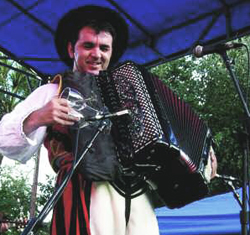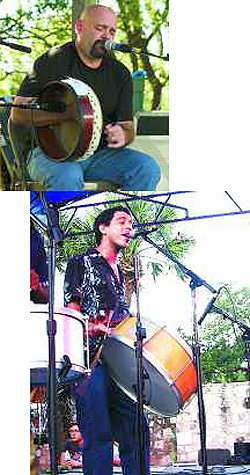
Unfortunately, getting the musician to trust you is another thing altogether. Unless there’s a quiet sound check time, where they can be shown the difference, chances are that once you set up the mic and turn your back, they’re going right back to the sound hole.
Interestingly, some of the bluegrass players we’ve worked with don’t prefer the Shure SM57 (gasp!). The reason given is that the windscreen on the SM57 rotates, and when the mic touches strings (especially on banjos), it creates some vibrations. A fixed screen instrument mic is preferable in their minds.
Mallet Percussion/Pan. Mallet percussion includes xylophone, marimba and vibraphone. These instruments have resonator tubes under the bars and can be difficult to mic evenly.
Vibraphones sometimes have pickups (again, usually Barcus Berry strips), but not often. We’ve found that placing two condenser mics, evenly spaced between the high and low bars, about 12 inches under the resonator tubes, will offer the best coverage.
Overhead miking doesn’t work well with these instruments because the instruments are not loud and you can’t pick up enough of the instrument without bleed from the rest of the stage overpowering it.
The pan, or steel drum, is in the same family and is miked the same way. As with the accordion, watch out for excessive low end on all these instruments.

Jembe, Ethnic Drums. Just about any good instrument mic can be used on hand drums. Typically, place the mic a couple of inches from the head on the side away from the musician. Some jembe players will want a second mic on the bottom.
Cajon. Also called a “box,” the cajon is exactly that, a hollow box with a hole in the back, that the musician sits on and beats. The best way to address the cajon is just like a kick drum – a Shure Beta 52 in the hole.
Step Dancers. If providing sound for a Celtic event, chances are that it will have step dancers. If there’s not a wood floor, they’re on their own!
For one or two dancers, a piece of 1/2-inch-thick plywood of decent size can serve their purposes. On the front of the board, in the middle, place a boundary mic, which will help get the sound of the shoes into the mix with the music. (And often, these bands will bring their own board.)
Bagpipes. Oh, what a conundrum! But well-played bagpipes don’t have to be a curse. Like accordions, bagpipes can be amplified with a pick-up or mics. The pick-up is always a nice surprise and usually, it only requires one line and a DI.
If going with a mic, then actually, two will be required – one for the drone and one for the chanter. The drone is the tall pipe that sticks up overhead. A SM58 or similar mic, positioned like a drum overhead, works nicely.
The chanter is the recorder-like piece that the musician plays with his hands. Another SM58 or SM57 on a short boom will do the trick. Note: Musicians rarely want any bagpipe in their monitors – they’re plenty loud on stage!
There are myriads of other instruments, most of which can be handled by a standard mic complement. Without experience, common sense and trial and error are still the best approach to the challenge.
The best part about these encounters is that we learn something new every time.
John and Teri Hogan owned Sound Services, a successful sound company based in Texas.
